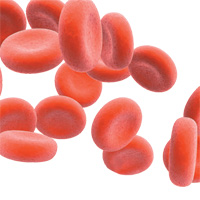“Iron-poor blood” sounds like an old-fashioned ailment, but it’s not. It’s still the most common 21st-century cause of a condition called anemia. “I had weakness, fatigue and a loss of concentration,” says Maria Steele-Voms Stein, 45, of the iron-deficiency anemia she experienced in her 20s. “I looked like a ghost walking around.” Although not diagnosed with von Willebrand disease (VWD) until she was 36 years old, the immigration paralegal from Pittsburgh dealt with symptoms for decades. The most debilitating was menorrhagia, heavy periods lasting up to two weeks. “Every month I was either in the midst of a menstrual period or recovering in an anemic state.”
Blood loss, whether acute or chronic, can lead to anemia. For people with bleeding disorders, anemia is avoidable. There are ways to diagnose, treat and prevent it. Although there are several types of anemia, this article will discuss two: iron-deficiency anemia and hemolytic anemia, the more common forms of anemia in people with bleeding disorders.
Anemia’s Effects
Hemoglobin, the pigmented protein that gives red blood cells their color, carries iron. When the body loses blood, from an injury, surgery, menstruation or a bleeding disorder, it also loses iron. Since iron carries oxygen to the cells, when iron loss exceeds the iron stored in the body, a person feels tired and weak.
Anemia ranges from mild to severe, which can cause serious symptoms. “If you become severely anemic from bleeding over a long time period, you may end up having significant shortness of breath and possibly chest pain if you’re an adult with an underlying cardiac disease,” says Aryeh Shander, MD, president of the National Anemia Action Council (NAAC), a nonprofit organization dedicated to raising awareness of anemia. He is also executive medical director of the Institute for Patient Blood Management at Englewood Hospital and Medical Center in New Jersey. Without enough hemoglobin, the heart has to pump harder to supply the body with the oxygen it needs. “Chronic anemias that are mild or moderate can cause heart problems.”
Whether chronic anemias cause cognitive impairment is a current conundrum. In December 2009, the National Institute on Aging awarded a $16 million grant for a national study of unexplained anemia in seniors. Studies of anemia in children have shown developmental delays in mental processing and motor skills. Since iron helps neurotransmitters function, a deficiency may contribute to memory and motor impairment.
An acute bleed, on the other hand, can mess with the mind. “When patients bleed significantly from a hemorrhage and they are anemic, until they get replenished with blood they may end up having cognitive dysfunction because of loss of oxygen to the brain,” says Shander.
For many people with bleeding disorders, nosebleeds are more than a nuisance. “If the amount of blood that is shed is either large during the nosebleeds—when it first starts until it gets controlled—or if it’s chronically oozing over a long time period, you will become anemic,” Shander says.
Surgery presents yet another opportunity for anemia to appear. It’s critical for patients with a bleeding disorder to have a pre-op blood test to determine hemoglobin and iron levels. If they are low, measures can be taken to restore them prior to surgery.
Public Health Issue
Iron-deficiency anemia in women of childbearing age in the US is so prevalent, yet underdiagnosed and undertreated, that the Centers for Disease Control and Prevention, the US Preventive Services Task Force and the American Congress of Obstetricians and Gynecologists consider it a public health issue, affecting millions of women. The main contributors are menorrhagia, iron demands during pregnancy and breastfeeding, and women’s smaller iron stores.

Adding a bleeding disorder to the mix compounds the risk of anemia. “Menstruation in a woman with VWD or another bleeding disorder tends to be excessive,” says Andrea Lukes, MD, MHSc, president and CEO of Carolina Women’s Research and Wellness Center in Durham, North Carolina. She is also founder and chair of the Ob/Gyn Alliance. “That challenge can deplete a woman’s iron supplies, resulting in anemia or lower hemoglobin.”
Iron demands increase by 50% during pregnancy. “You have an increase in your blood volume, which requires a good reserve of iron,” Lukes says. Although pregnant women are advised to take a multivitamin with iron throughout their pregnancy, they can still become anemic. Severe anemia can disrupt life in the womb, from decreasing the volume of amniotic fluid to causing abnormal heart rate patterns and oxygen levels in the fetus. It can also trigger preterm delivery and low birth weight. If you are a carrier or are a woman diagnosed with a bleeding disorder, ask your physician if you or your fetus has an increased risk of these complications.
After the birth, anemia is still possible. “During the postpartum time, women are at risk for a worsening of the anemia because they’ve just gone through labor and either had a vaginal delivery or c-section, with an increase in blood loss,” says Lukes. That scenario is familiar to Stein. “After my daughter’s birth via c-section, there was a heavy loss of blood,” she recalls. A radical hysterectomy kept her in the hospital for a week. “I was anemic at that point and was treated with transfusions.” Her VWD diagnosis was not made until the following year.
Anemia of Chronic Disease
Long-term inflammatory diseases, such as some autoimmune diseases, cancer and infections from hepatitis C virus (HCV) and HIV/AIDS, can cause anemia of chronic disease. This type of anemia results when a long-term medical condition affects the production and lifespan of red blood cells.
According to the NAAC, 67% of people with hepatitis C who are on the combination therapy ribavirin-interferon develop anemia. “Typically, we see people present with fatigue and tiredness, although very often they can be confused with the symptoms of hepatitis C or even interferon,” says T. Jake Liang, MD, chief of the Liver Diseases Branch of the National Institute of Diabetes and Digestive and Kidney Diseases (NIDDK), one of the National Institutes of Health, in Bethesda, Maryland. “Physicians who treat patients with hepatitis C need to be vigilant about the impact of anemia on the symptoms.”
Ribavirin is the culprit, causing hemolytic anemia, an abnormal destruction of red blood cells, about four weeks after therapy begins. But how it destroys the cells is unknown. “It may have something to do with the way the drug gets into the body, accumulates in the red blood cells and becomes toxic,” Liang says.
If a blood test reveals the patient is anemic, reducing the ribavirin dose or discontinuing it for a few weeks often allows the hemoglobin levels to rise. “Unfortunately, in about 5% to 10% of patients, you have to stop the ribavirin or keep it at a very low dose, which tends not to be very effective,” says Liang.
An alternate therapy is gaining popularity—the use of erythropoietin-stimulating agents (ESAs) that prompt red blood cell production. “They work pretty well, keeping the blood counts at a reasonable level, so patients can continue to receive ribavirin at an effective dose,” Liang says. Although this use of ESAs is considered off-label, says Liang, it is generally accepted in the medical community.
However, studies show that ESAs can cause cardiovascular complications, including heart attack, heart failure and stroke. Further, they are expensive. “Recent data suggest that erythropoietin growth factors can also cause tumors, so we try not to be too cavalier about prescribing them,” Liang says. “We don’t use them for an extended period, usually only for a few weeks.” The US Food and Drug Administration issued a safety announcement in February 2010, requiring prescribers to complete a training module.
In HIV/AIDS infection, HIV attacks the platelets directly, but its effects on red blood cells are indirect, causing chronic disease anemia. Anemia in these patients can also be caused by chronic infections, such as atypical tuberculosis, and certain drugs, such as AZT (azidothymidine). Doses are adjusted to avoid this outcome. “Anemia is very uncommon in those who receive HAART (highly active antiretroviral therapy),” says Margaret Ragni, MD, MPH, professor of medicine at the University of Pittsburgh and director of the Hemophilia Center of Western Pennsylvania. “If you are co-infected with HCV, you can also develop a mild hemolytic anemia due to ribavirin. That’s why we need careful monitoring of blood counts on all individuals with HIV and/or HCV infection. Blood counts provide a good window on what’s going on with the HIV disease.”
Patients with bleeding disorders who are co-infected with HIV/AIDS and become anemic are also given ESAs to crank out more red blood cells. Managing the treatments for multiple conditions can be tricky. “This requires careful coordination of the medications. It does take a lot of experience to deal with these complicated issues,” says Liang.
Testing for Anemia
Confirmation of anemia comes via a simple blood test, called the complete blood count (CBC). The CBC measures the hemoglobin and hematocrit, the percentage of blood made up of red blood cells in the sample. According to NAAC guidelines, you are anemic if your hemoglobin count is <12 g/dL (grams per deciliter) for a nonpregnant woman and <13 g/dL for a man, and if your hematocrit is >36% for a woman or >39% for a man.
“You can also measure iron stores and do iron studies,” says Lukes. A serum ferritin test reveals how much of the body’s iron store is depleted. According to NAAC, it is the best way to differentiate between iron-deficiency anemia and anemia of chronic disease.
Treatment for Anemia
Treatment for anemia depends on the cause. Physicians need to assess whether the anemia is due to a dietary deficiency, iron loss or inability to take iron, says Shander. “Patients with bleeding disorders are not immune to having dietary anemias,” he says. Stein revamped her diet 20 years ago after her diagnosis. “They recommended that I eat foods that were higher in iron, like leafy green vegetables and meats,” she says. (See sidebar, “Do’s and Don’ts of Iron Supplements.”) If you are diagnosed with anemia, you should meet with your hematologist to discuss the best treatment option for you.
 Ingram Publishing/Photolibrary
Ingram Publishing/PhotolibraryLukes usually first recommends patients try ferrous sulfate, an oral over-the-counter iron supplement. Since iron supplements can cause constipation or upset stomach, patients should test brands to find one they can tolerate. How long patients take iron is another matter. It can take up to a month or longer for iron stores to be rebuilt and to prevent the return of anemia.
“Some women can be chronically anemic from heavy periods. They may need to stay on long-term iron therapy until bleeding is managed or stops with menopause,” Lukes says.
Iron injections are usually recommended for patients who have lost a large volume of blood, are being given ESAs or who cannot absorb iron taken orally. They are delivered to the bloodstream, building red blood cells quickly. Blood transfusions are reserved for cases when other measures fail or there is an immediate need, Shander says.
“I lived a lot of my adult life with anemia because of the heavy menstrual bleeds,” says Stein. “If you feel something is wrong, there probably is.”
[Steps for Living: Healthy Eating]


 Some foods, vitamins and medications can affect iron absorption. Consult your physician before you take iron supplements. These guidelines can help you get the most out of your supplement and avoid problems.
Some foods, vitamins and medications can affect iron absorption. Consult your physician before you take iron supplements. These guidelines can help you get the most out of your supplement and avoid problems.